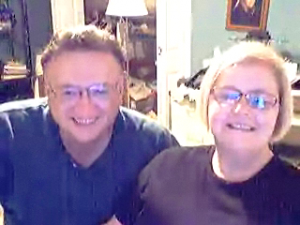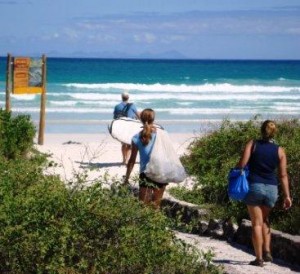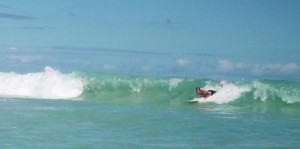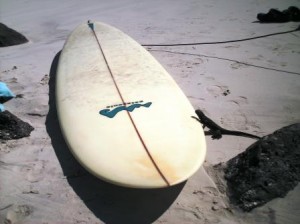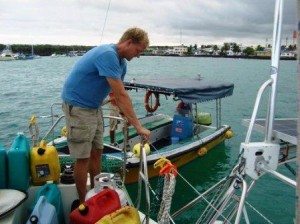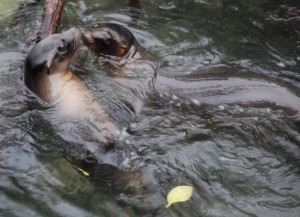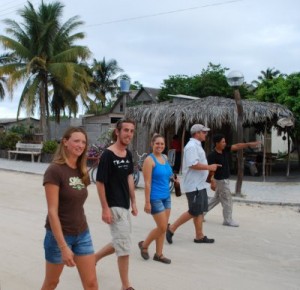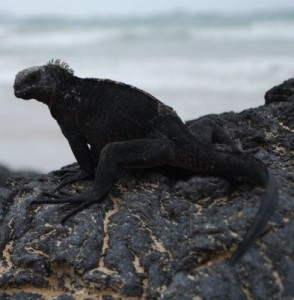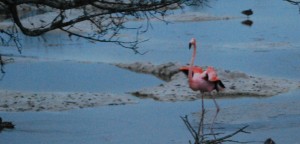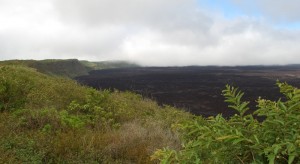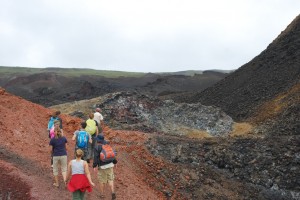Lat: 2 48.011′ S
Lon: 99 41.247′ W
We are continuing to make westerly progress through the South Pacific with not another soul in sight. Even the birds are few and far between out here. Since we are in the southern hemisphere, it is getting dark fairly early (around 6 pm), which is strange since you are having the longest days of the year in the U.S. The trade winds have been light to moderate at around 10-20 knots from the south/southeast. All of this would seem to create conditions for a nice, peaceful passage, but that would be just too easy, wouldn’t it?
On Sunday we were sailing on a broad reach (wind coming from the aft quarter) using the mainsail and spinnaker when things got a little more interesting. I was doing dishes in the cockpit during my watch just before sunset when all of the sudden I heard a noise, looked up, and saw the mainsail drooped down over the bimini. Apparently the halyard that holds it up chafed completely through on metal at the top of the mast. Since night was approaching, Dallas and I quickly stowed the main in its cover and called it a day, but not before Dallas used the binoculars to take a look at the others halyards and noticed that the spinakker halyard appeared to be seriously chafing at the masthead as well. Needless to say, Dallas spent some time that evening contemplating how he was going to address these problems at the top of the mast. He mentioned that the author of a book he was reading suggested that when selecting a crew member, one should consider candidates’ abilities to go up the stick when out at sea. Dallas realized apprehensively that he was about to demonstrate his ability to do just that.
There was more work to be done before that could occur, though. Once again, it was on my watch, this time at 4:00 a.m. on Monday. I was reading just inside the cabin and noticed that Jupiter was no longer in sight and we appeared to be veering off course. I stepped into the cockpit, looked up, and sure enough, we had no sails up and were dead in the water! Fortunately Dallas had warned that the spinnaker might fall during the night (as a result of chafing), so I wasn’t surprised. I just woke Dallas up, and he and I got to the business of dragging the spinnaker out of the water. We then put the jib out and got right back on course.
I managed to get a few hours of sleep before Dallas woke me up on Monday morning so that I could assist with his first trip up the mast. Wes winched him up, Tiff tailed the line, and I kept tension on the two lines that Dallas took up with him (as well as keeping an eye on Dallas!). Fortunately the wind was light and the seas calm, but Dallas reported that it felt as though the boat was pitching considerably as he straddled the top of the 49′ stick. After 10 minutes or so, he had managed to move a block from the port to the starboard side (since we will most likely fly the spinnaker on a port tack all the way to the Marquesas) and had run the new spinnaker halyard up the outside of the mast (rather than the inside) to prevent chafe. He came down queasy and with more chafe to speak of–this time on the inside of his legs (ouch!). After a brief rest and some lunch, he was back at it again. He had me roll in the jib while he put the spinnaker up. At that point, I went for a rest of my own and got up to hear the crew taking the spinnaker down again! Apparently the wind clocked around to forward of the beam, so what we really needed was the mainsail…
Since all of the other halyards were in use or chafed through, Dallas ran a line up the mast on his first trip up that served as a temporary topping lift so that he could use the regular topping lift (the line that extends from the end of the boom to the top of the mast and back that holds the boom up) to get him up the mast for yet a second time on Monday. Once again the winds were light, and I was able to winch him up with only a little bit of miscommunication. Within an hour or so he had added a block to the masthead, used it to run the main halyard, come down from the mast in one piece, and put the mainsail back up. I’m getting tired just thinking about it!
Today has been much more relaxed and care-free by comparison. We aren’t quite going fast enough to make up for the lack of progress yesterday, but we are currently sailing at about 5 knots on a broad reach using the main and jib. It is comforting to know that we have full use of our sails again, especially since we are ever so reluctant to use the motors. I did turn on an engine for an hour this morning only because our battery capacity was at an all-time low.
Speaking of battery capacity, it seems that we are officially without refrigeration for the rest of this passage. We just don’t have the juice, although at this point, it is not a major loss since we have eaten up all our fresh produce and have only a bit of cheese and some condiments to chill. (Incidentally, many items such as condiments do not HAVE to be refrigerated. Surprisingly even mayo will keep at room temperature as long as you don’t put bacteria-laden utensils in the jar.) We will miss having ice as well. Oh, and we ate up the last of the bread from the Galapagos today. Do you feel sorry for us yet? Ha ha. Never fear. We are still eating well and even had some assistance from the guys in getting supper ready tonight. Wes and Tiff did the dishes, while I assisted Dallas with a potato dish that he came up with. We steamed the potatoes in salt water to conserve fresh water, and they turned out really well, as did the dish in general. Hopefully the limited resources in the galley will continue to elicit creativity.
Lat: 1 44.585′ S
Lon: 94 26.957′ W
2701 miles to go…
To begin, we have to give a word of warning. The sat phone wasn’t working yesterday and my computer died yesterday as well. Charging the sat phone seemed to help even though one of its battery indicators said it was fine. After a bit of effort, I was finally able to get the sat phone e-mail software installed on Tiffany’s computer. We just wanted to let you know that we are having some communication problems just in case we’re not able to post blogs until we get to the Marquesas.
The blog we posted earlier today was actually written Friday morning. Today, there were only 20 squid on deck, although I found 2 or 3 more on the anchor which could have come either day. Even though we’re a couple hundred miles from the Galapagos, we’re still seeing birds frequently of a couple different varieties. As usual, they like to fly close to the green starboard navigation light at night.
I tried my second noon sight today, and even though some thick clouds kept getting in the way, the latitude was off by less than a mile. That’s two good sights in a row, so I feel a little more confident that even if all four or so of our independent GPS systems were to fail, we’d still make it in.
Food has been great as usual. We’ve taken advantage of the recent provisioning to have things like salad every day before the lettuce goes bad. Yesterday we also had haystacks, a sort of taco salad with chili that is one of my favorites. This morning before dawn, as I was taking over for Lauren, she baked a papaya crisp for breakfast that is basically the same as apple crisp but with a fresh papaya that we picked up in Puerto Ayora instead of
apple. It was tasty.
The frig/freezer has been running a lot lately and our batteries got so low yesterday that we had to turn it off (we could have run an engine for an hour or two, but who wants to do that). It seems like we’ve either lost half of our battery capacity or the battery monitor is confused about how much we’ve been drawing from the batteries. We’re hoping it’s the latter, especially since the battery monitor has made some odd claims in the last week or two. The solar panels have been doing as well as they can, but in the afternoon, with the sun in the northern hemisphere and us on a port tack, they’re shaded by the mainsail and can’t deliver much power.
The wind generators haven’t generated much electricity since we left, especially with fairly light winds the last day or so. Our speed had slowed to between 3 and 4 knots, so we finally put up the spinnaker. We’ve had so much fun learning to raise and lower it, that we’re a little slow on the draw in terms of putting it up. This time, except for one minor hitch, we raised it without any problems. We even have both corners of the sail tied to sheets that run through blocks to winches so that we can adjust both corners. Hopefully, we’ll be able to leave it up for a while. While the boat was slowed and we were getting the spinnaker ready to hoist, we spotted a 3-foot Mahi Mahi checking out the boat. He cruised around the boat several times while we were getting things setup. Their colors are really amazing.
True to form, now that we have the spinnaker up, the wind has freshened enough that there are numerous small whitecaps and we’re consistently at 7-8 knots with bursts of speed over 9 knots. Hopefully the wind follows the pattern it has the last couple of days in blowing the hardest in the afternoon and then easing off the rest of the day. The spinnaker and mainsail together is way too much sail to have up in a blow and they spinnaker is not easy to drop.
Lat: 1 29.594′ S
Lon: 92 11.843′ W
2836 nm to go…
After 10 great days in the Galapagos, it was time to get moving again. Wes, Tiff, & Lauren
had done the final provisioning and I’d completed the items on the repair and maintenance
list. Because of the distance of this passage, we made sure all our water jugs tanks,
jerries, jugs, bottles, etc. were full before leaving. This required several trips to the
water store to fill our five 6-gallon jugs. In total we are setting off with 140+ gallons
of water, which should be plenty given the good sailing conditions we’re expecting and the
water conservation abilities we’ve developed. We pulled the anchor at 3:30pm yesterday with
Lauren at the helm and the GPS reading 2957 nautical miles to the waypoint we set just south
of Hiva Oa.
Here’s a bit of arithmetic on the passage distance, time, etc. On our previous passages,
4.5 knots was a good average speed for us. At that rate, the 2957 nm would take us 29.4
days (a nautical mile is 1.15 land/statute miles and knot is one nautical mile per hour).
At 5.75 kts, the passage takes 21.4 days, and at 6 kts it takes 20.5 days. Every quarter
knot of speed is about a day difference in our passage time. Our goal is to stay above 6
kts and make it in three weeks. Because of this arithmetic, I spent about 2 hours yesterday
morning in the water cleaning the bottom. The water here in the Galapagos is great for
marine life, including several varieties that grow on the hull of a boat — brown gunk,
green algae/weeds, etc. It’s not perfect, but it’s two hours of cleaning better, our
rudders are now blue again instead of brown, and I had a rag on almost every square inch of
the bottom, so I hope it gives us the extra quarter knot or so.
The waves were a bit steep as we were leaving, but they are much better now that we’ve
sailed out into deep water. Last night was one of the more beautiful nights on our trip.
The clouds were fairly minimal, allowing us to see lots and lots of stars. Lauren mentioned
that we should be able to see the Southern cross from here, I looked up, and there it was
off to port! To starboard we could still see the big dipper, although I think part of it
will be gone over the horizon by time we reach Hiva Oa. We pulled out our star charts and
found several stars, including Spica, which is the name of a boat we met in Shelter Bay.
I’ve been reading Bowditch and the looking over the Nautical Almanac the last few days and
finally got to try a noon sight with the sextant today. I was pretty happy when it turned
out to be fairly straightforward and the result came out within 3 miles or so of our actual
latitude. We’ll see how I do tomorrow. Just as the almanac showed, we also saw Jupiter
rise about 10pm and begin climbing quickly through the sky.
This morning when I came on deck for morning watch, Lauren asked me to toss over a squid
that had found its way on deck. “I think I saw another one somewhere else as well,” she
said. A few minutes later, after making my way all around the deck, I had tossed 58 squid
back into the water! They ranged in size from just over a couple inches to about 6 inches
or so.
We’re no longer within sight of the Galapagos, so I pulled down the Ecuadorian courtesy
flag. Next stop Marquesas.
Since returning from Isabela, we have struck a nice balance betweeen taking care of boat-related business and enjoying Puerto Ayora. I took Dallas up the mast on Sunday afternoon so he could assess the rigging, and he was pleased that everything was still in place and seemed to be secure. That night we found a restaurant that had the NBA finals on TV (with Spanish commentators). Dallas has been a Lakers fan for years (long before we moved to L.A.), so I was glad that he was able to see them clinch the championship. I was also glad to have the chance to skype with my parents that night. I am going to miss being able to see them as well as hear their voice when we are in the technologically primitive Marquesas Islands.
After a nice pancake breakfast that Tiff prepared on Monday morning, Dallas changed the oil on both engines. We then headed in for an afternoon at the beach. We thought we were taking a taxi to Tortuga Bay, but the taxi driver informed us that it was necessary to walk for 40 minutes. We unloaded our surfboard, snorkeling gear, backpacks, etc. and started walking. Despite the gear and the bright sun (it was the first clear day since we arrived here), it was a pleasant walk on a paved trail through the forest of cacti and deciduous trees. The beach was beautiful, and Dallas, Tiff, and I all took turns on the surfboard. The waves were great in terms of their height and frequency, but they closed out pretty quickly, so there wasn’t much time to try to stand up. I’m sure that experienced surfers could have handled it, but we are as novice as they come. Dallas seemed on the cusp of getting up, though, and I am determined to get there soon as well. After surfing we walked down to the bay, which was very peaceful but very murky, so we could have left the snorkeling gear on the boat. Some others that were just leaving told us that they had seen a big ray there, but I don’t think I would have seen anything in that green water until it brushed up against me.
Monday night was girls’ night out. Tiff had been craving sushi, which doesn’t appeal to the Clow brothers but definitely appeals to me. We went to a nice place overlooking Academy Bay where the boat is anchored. While the sushi was not the best we’d ever had, it served to satisfy the cravings. Afterward we stopped at a little place called Cafe Limon where we could get a cheap drink among both locals and tourists and take up space on the dance floor. They played a nice mix of salsa and American dance music. Naturally we had some unsolicited conversations with a few friendly Argentinian and Ecuadorian men. You might think that the fact that Tiff and I do not speak Spanish might have deterred them, but think again. They just kept talking, and eventually we’d understand a key word that would help them to communicate to us their occupation, for example. It was remniscent of the game show where you can say anything except the words you want to convey, and Tiff and I were pretty amused.
I did learn one word that I really like. It turns out that “Pachamama” is not just the name of a restaurant in Kansas where my best friend works but is a term used by the indigenous peoples of the Andes to mean Mother Earth. One of the guys who was born and raised in the Galapagos (he’s one of the endemic species, LOL) used this word several times, and Dallas and I saw it on a mural yesterday. Pachamama is revered on these islands.
Yesterday we went about the business of collecting water and diesel for the 3,000 mile journey to the Marquesas Islands. This going to be the longest passage of the whole circumnavigation, and thus it requires that we are all stocked up. Typically this is no big deal–we just pull up to a dock, plug in the fuel/water hoses, and go. However, this time we have had to supply using jerry jugs. For water, we took our jugs to and from shore using the water taxi, got them filled at the local desalinization plant, and carried them three blocks to the water taxi dock. We tried to do the same for fuel by taking our jugs in a taxi to the gas station but were told by the attendant that we would have to get a diesel permit from the port captain (i.e., pay more money since we are tourists). We had some forewarning that this would occur but were trying to get around it. Oh well.
Today we will take care of final provisioning and savor our last minutes of internet. I have been following the situation in Iran since their presidential election and will be interested to see how that plays out, although we probably will not read about it again until we get to the Marquesas in 3+ weeks! That also means that we may not get back to those of you who email us for a while, but keep those emails coming anyway! We love to hear from you!
We started by dropping our stuff off at the hotel, where we had a bit of a laugh. Lauren I left so soon after getting married, that we didn’t have a chance to have her name legally changed, passport re-issued, etc. When we arrived at the hotel, they had assigned Wes and I to share a room since we had the same last name. When I explained that we were brothers and we’d prefer to stay with the girls rather than each other, the proprietor had quite a laugh. The hotel was simple but cute, and we were looking forward to having internet, TV, air-conditioning, and hot water all together. It didn’t quite work out that way, but oh well. The TV was mostly in Spanish of course, but we did find a channel that had English with Spanish subtitles. We watched parts of a WWII sub movie that was a combination of German with Spanish subtitles and Spanish dubbing. We were able to follow a fair amount of it, but it was definitely easier to understand the German with Spanish subtitles than to try to understand the quickly spoken Spanish. I never did get any hot water, which makes my last hot shower on the other side of the Panama Canal with no hot shower in sight.
After dropping our stuff off at the hotel we met Julio, who was our guide while we were there, and took a walk around the town. Our tour that evening included a small mineral-laden lagoon with a couple of flamingos at the opposite edge (Lauren and I walked by later to get some pics of them much closer and got to see one fly) and a walk along the beach where we saw lots of marine iguanas and crabs as well as some local kids surfing. It is really amazing how well the marine iguanas blend into the black volcanic rocks. There have been several times when we were looking right at a couple of them and didn’t initially see them. Juliio left us for the evening and we did a little exploring and learned that there was an election in Ecuador on Sunday, so all the local beach-front bars were closed Friday, Saturday, and Sunday by law. That was a little disappointing because there were some really neat places with stools and hammocks right at the edge of the beach.
We had all of our meals included at the hotel, so we went back for a tasty dinner where we were warned by a fellow tourist that we would be in for a pretty rough day on Saturday (rain, mud, sunburn, weeds, brush, etc.). She seemed to complain about everything though so we pretty much ignored her. We also had a nice conversation with Zachi, an Isreali guy with our same itinerary in Isabela who is in the middle of an 8-month sightseeing trip that has included several parts of South America.
We were hoping for a good night’s sleep, but Lauren and I had left our windows open with no AC (we’re more than accustomed to it now, and the weather has been great) and about 4 in the morning, the neihborhood roosters started the morning crowing ritual. They seem to have a 6th sense with respect to how long they need to crow to wake up everybody in earshot, not stopping until breakfast is on the table. Oh well. We were excited to see a volcano and didn{t need a lot of sleep.
After breakfast we loaded up in what they termed a “bus”. It was a pick-up with a wooden structure on the back instead of a bed. It had three rows of seats, no seatbelts, and just an armrest to keep you from sliding out. Luckily, there’s not much in the way of traffic there, so no worries. We drove halfway up the mountain with steadily increasing mist until we got to a place where the horses were saddled and waiting for us. The local that worked with the horses picked one out for each of us and we saddled up. In general, the reins were just some roped tied to the halter & bit, the saddle blanket took a variety of forms (old rice bag, carpet, etc.), and some of the stirrups were tied to the saddles with ropes. We looked a little motley crew, with only one of us having any real amount of riding experience, but we set off into the fog. The guide had us continuously yelling at the horses to keep them moving faster, and we later found that the horse hand would ride in the back with a long rope and smack the hind end of the horses in the back. Needless to say, the horses didn’t like being the back and would ride up against each other trying to get closer to the front. There were lots of cries of “I’m sorry”, “Oooooo”, “Looks like I’m passing you…”, etc. My horse seemed to be a little too weak to make the trip, and in the very muddy conditions kept slipping, falling down almost to it’s knees once on the way there and again on the way back in some very muddy sections. I was able to keep my balance and stay on, but I was definitely thinking about how to get out of the way of the other spooked horses if I fell off.
We climbed to the top of the mountain, and then got to ride for a mile or two along the edge of the cauldron of Volcano Sierra Negra. The clouds were only covering about half of the cauldron at the time, which made it quite a spectacular sight. The volcano last erupted in 2004 or 2005, and the eruption was farily weak. All of the lava stayed in the cauldron and only covered about 60% of the surface area there. All of the people in the town actually came up and stood at the edge of the cauldron to watch. After viewing the cauldron, Julio led us on a walking tour along the other side of the volcano (Volcan Chico). Here there were several small craters off of the same magma chamber, with the last eruption 30 years ago. Parts of it were like walking on the surface of another planet. Seeing the different kinds of rocks with a variety colors dependent on their mineral makeup was amazing. There were lava tunnels, a lava river, folds of lava, a lava waterfall, and several small craters. We had lunch at and altitude of about 850 meters overlooking the dry side of mountain. From where we sat we could see the area where the lava from the next large volcano farther north had flowed toward the lava from this volcano and formed a connected island with a bay on each side, sort of like an hourglass shape.
We reversed the horse and bus conveyance back to the hotel. The horse ride was a little hair-raising with all of the mist/rain that had fallen. Tiffany was yelling/screaming almost the whole way back as her horse would ride along the edge of the brush, trot by brushing against other horses to avoid the horse hand, and then go sliding/trotting quickly down slippery downhill secions. The bus ride was pretty uneventful except for the milk cow that had wondered into the road and was chased by the bus for half a mile or so. We got 10 minute at the hotel to change clothes, pick up snorkeling gear, and load up for Tintoreras. Tintoreras is the Spanish word the the white-tipped shark and is the name they’ve given to a small island area by the entrance channel to the harbor. This turned out to be a pretty amazing place. within a distance of only half a mile or so we saw numerous white-tipped sharks swimming in a small channel off of the little lagoon, lots and lots of marine iguanas, sea turtles, sea lions, blue-footed boobies, and Galapagos penguins. Pretty amazing stuff. The snorkeling was only so-so. The visibility wasn’t very good so we only stayed in half an hour or so. We did see angelfish, several other colorful fish, and a couple of 3-4 foot rays.
We were pretty tired after a long day, so after dinner we relaxed in our rooms and went to bed early. The bus left for the dock at 5:30am and we were back in Puerto Ayora by 8:30am. We asked around and the locals pointed us to a local restaurant facing the harbor for breakfast. It was great food again. Wes was adventerous and tried the Bolon con Queso — banana dumpling with cheese, which seemed to be one of the more common selections among the other people at the small restaurant. Then it was back to the boat for a nap and a closer look at the rigging. The mast has moved in the mast base and seems to be moving more than it seems like it should, so I’m looking things over, taking some pics, and talking to Colin at Mack Sails to try to make sure everything is OK before we take off for the Marquesas.
We pared the pictures we took down to 600 or so, but it is still going to take a few days to get them all uploaded, so be sure to check back.


